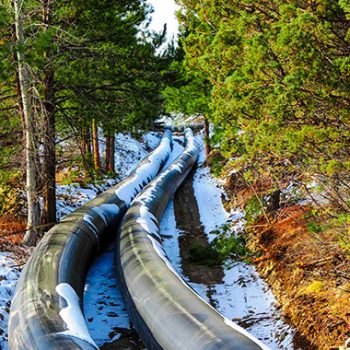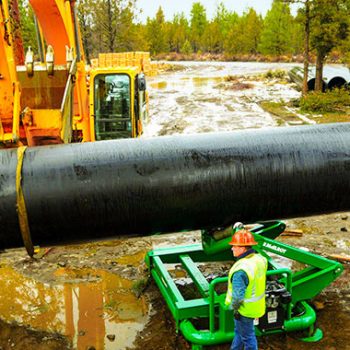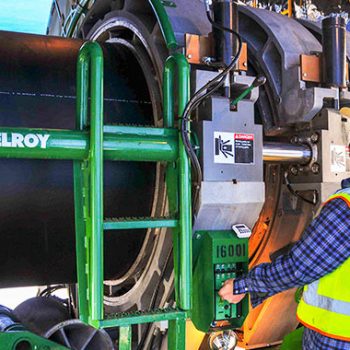Whychus Creek has provided irrigation water to farmers in Three Sisters Irrigation District in Central Oregon since 1888, but through inefficient canal systems that lose up to 50 percent of the water before it reaches the farms. To remedy the problem, Three Sisters Irrigation District (TSID) chose to eliminate seepage losses by piping their main canal with twin 54-inch high-density polyethylene (HDPE) pipes.
The water that was typically lost in the canal that flows through the Deschutes National Forest is now being conserved through HDPE piping. The resulting water conservation will boost various fish species’ populations, including steelhead trout, which are listed as ‘threatened’ by the United States Fish and Wildlife Service. Bull trout and Chinook populations also stand to benefit from the increase in water.
The water is also used to generate green energy through a hydroelectricity plant at the end of the pipeline. Farmers in the region could also use the water for irrigation in dry years.
The $10 million, three-phase Whychus Creek rehabilitation project was partially funded by an American Recovery and Reinvestment Act of 2009 (ARRA) grant given to the Deschutes River Conservancy (DRC) to improve water quality and fish habitats in the Deschutes River system. “The Three Sisters Irrigation District (TSID) Main Canal project is very significant within the context of the Deschutes Basin,” said Scott McCaulou, program director for the Deschutes River Conservancy. “The project will help boost in-stream flows in what is regarded as the most critical stream reach in the upper Deschutes Basin for reestablishing steelhead trout populations. Steelhead were extirpated from the upper Deschutes Basin in the 1960’s by the construction of several large dams. The TSID Main Canal project will provide benefits to fish, wildlife, and local communities for generations to come. The TSID Main Canal is the DRC’s flagship ARRA project due the environmental benefits and it represents our single largest investment of ARRA funds.”
With the funding, TSID purchased 30,000 feet of 54-inch high-density polyethylene (HDPE) pipe for the first two phases of the project. The 3.77 mile pipeline project featured dual 54-inch lines that were buried and that conserve irrigation water that is returned to Whychus Creek. The pipeline begins at a diversion dam and terminates at the 80-acre Watson Reservoir. At the reservoir, two Francis turbines generate 1.5 megawatts of energy for the Central Electric Cooperative and the city of Sisters, as well as producing a potential $300,000 per year in revenue for TSID.
Three Benefits for Three Sisters
The Deschutes River Conservancy, Three Sisters Irrigation District, Upper Deschutes Watershed Council and other organizations have combined their efforts to benefit central Oregon in three ways from the new pipeline installation.
The major goal is to improve stream conditions for resident trout and reintroduced steelhead salmon that are currently on the United States Fish and Wildlife Service’s Endangered Species Act species list. Freshwater streams are critical to steelhead, which are born in freshwater and spend their first three years of life in freshwater. After an emigration to the ocean, steelheads return to spawn in the freshwater streams.
To keep the fish out of the pipelines, a fish screen will be constructed.
“We’re going to be installing a state-of-the-art Farmers Conservation Alliance fish screen that will connect to the pipeline,” said Marc Thalacker, manager of the Three Sisters Irrigation District. “There’s a chance we’ll have spawning adults coming all the way up to Sisters. They haven’t done that since 1887. As a result, those fish alone can double the steelhead run in the Deschutes River.”
Sounds like a win-win for everybody
With more than 60,000 water dams and diversions in Oregon, fish screens are increasingly used to keep fish out of dangerous areas within waterways. The fish screens can be created in horizontal or vertical systems, and are often custom designed to meet the needs of the site. If successful, the fish screen will keep fish from entering the pipeline; allow screened water to continue down the pipeline for farmers and hydroelectric power; and offer low operation and maintenance costs.
The rehabilitated canal offers six cubic feet per second more water due to the water conservation achieved through piping the irrigation canal. With the increased water flow, Whychus Creek could be rescued from the Oregon Section 303 (d) listing for not meeting proper water temperature expectations for beneficial use of fish spawning and migration. The primary cause of the insufficient water temperature, according to an Upper Deschutes Watershed Council Water Quality Monitoring Program grant report, was reduced in-stream flows due to agricultural uses. The canal gets the majority of its water from annual glacier and snow melts.
Knowing that increased flow was needed to promote spawning and migration, the DRC set an in-stream flow target of 20 cubic feet per second. That target was met by the new pipelines.
Instead of having to pump water, farmers can turn to the rejuvenated water source for irrigation. This increased water supply could boost Oregon’s agricultural crop exports that already account for 69 percent of the state’s total sales, according to the Oregon Agriculture in the Classroom Foundation. The state leads the nation in production of some unique crops, including blackberries, hazelnuts, ryegrass seed, fescue seed, Christmas trees and storage onions. Oregon is also the second largest producer of peppermint in the United States.
Not only is the farmland in the Deschutes River Basin excellent for some crops, but also supports cattle for dairy and beef products.
With the 54-inch pipelines online, as well as a 36-inch irrigation HDPE pipeline, it’s possible that farmers will be able to turn off their pumps and conserve energy.
Of course, the energy aspect of the project is the icing on the cake. By harnessing the increased pressure and flow as the water moves through the pipeline, TSID created revenue that allows the farmers in the district to pay for part of the project.
Two Francis turbines use the stream’s flow for electrical power production. A turbine is attached to each pipeline, and the electricity is either be purchased by Central Electric Cooperative, or “wheeled” across their system to Pacific Power.
The Francis Turbine was invented in 1848 by James B. Francis, who created a turbine with 90 percent efficiency. The inward flow reaction turbine combines radial and axial flow concepts to achieve high efficiencies, and those same efficiencies provide green power from April to October each year. The 1.5 megawatts generated is enough to
“About 90 percent of our power is generated by the Columbia River basin system of federal hydroelectric power dams operated by the U.S. Army Corps of Engineers and marketed by the Bonneville Power Administration,” said Alan Guggenheim, member services director for Central Electric Cooperative. “It is my understanding that the Three Sisters Irrigation District project would help save water and energy with zero carbon emissions into the atmosphere. Sounds like a win-win for everybody.”
PE and the Process
HDPE was chosen for the project because of the inherent characteristics of the pipe material. The pipe is flexible, can curve and snake with terrain, can weather the ground movements in areas of seismic activity, and resists corrosion and cracking. With this project, 50-foot sticks of pipe are delivered to a staging site, where they are then butt fused to a length of pipe one at a time, creating a long, continuous pipeline.
The HDPE pipe was manufactured by JM Eagle, and consists of four different wall thicknesses. The pipelines stair-step upwards in wall thickness where the flow and pressure within the pipe grow. At the least pressurized end, 54-inch DR 32.5 rated for pressures up to 50 psi was used. DR 26 and 21 are used in the middle, with DR 19 pipe rated for pressures up to 90 psi used leading to the turbines at the end of the line.
Several pieces of McElroy fusion equipment were used on site. McElroy’s largest fusion machine, the MegaMc® 1600, was used to fuse the lengths of pipe together. Capable of fusing pipes sized up to 65 inches in diameter, the MegaMc 1600 is McElroy’s largest fusion machine and was provided by ISCO Industries.
Another advantage to choosing the MegaMc 1600 was the machine’s clearance. While some fusion machines on the market typically require a crane to lift the heater and facer into the jaw carriage of the machine, the 1600 has a hydraulic pivoting heater and facer. Aside from not needing additional equipment, the 1600 can be tented to protect the fusion joint and operators from adverse working environments. Since the canal is dry during the winter months, before the glacier and snow melt, workers fuse the pipe during the winter months and routinely fuse through freezing temperatures and winter precipitation without a hitch. The lengths of pipe are then pulled into position in the empty canal.
To better move the very heavy pipe, TSID employed two McElroy productivity tools. As the length of pipe was pulled out of the machine, a pipe roller was used approximately 30 feet from the fusion machine. The pipe stand keeps the pipe at a fixed height to make matching the pipe ends to each other much easier. On the other side of the MegaMc 1600, TSID incorporated a MegaMc® Pipe Stand, a gasoline-powered pipe stand with rollers that allows the operator to move the pipe horizontally and vertically in order to achieve optimal alignment. Pipe stands are critical for saving wear and tear on fusion machines, while making the fusion process much easier for the operator. Operators on site believed the powered pipe stand saved up to 30 minutes on some fusion joints.
Thalacker requested the MegaMc Pipe Stand specifically for this job. He believes having the proper job site setup saves time and money in the long run. TSID calculated that the pipe stand’s ability to maneuver a stick of pipe horizontally and vertically save valuable minutes on each fusion joint.
By using the MegaMc 1600 and Pipe Stand, the team of TSID workers averages six fusion joints per day.
After the lengths of pipe were completed, air vents were installed each quarter of a mile and pressure vacuums every half to three-quarters of a mile.
Overall, the project was planned to last until 2012, with the fish screen installation as part of phase two in 2011. The final phase consisted of putting in the twin Francis turbines and finally creating renewable energy.
All products used to accomplish the project were made in America and have Buy America certificates associated with them.
Challenges
With Whychus Creek flowing through Deschutes National Forest and its potential benefits to the endangered species, farming and green initiatives, the pipeline’s construction came with challenges for TSID.
Having constructed approximately half of the irrigation district’s 60 miles of piping in HDPE using local farmers as workers, TSID used some of the funding to hire a full-time crew to operate heavy machinery for digging out the creek and fusing the HDPE together. With the ARRA’s goal of creating jobs in mind, Thalacker hired a crew of six to work on the project. The additional crew required more safety training sessions, and presented challenges of training on construction equipment.
Working in a pristine, treasured environment, like that of a national forest, comes the challenge of navigating obstacles, including a mandate that states each tree must remain in place. While trees were not removed – a scenic irrigation ditch was eliminated for a more efficient system, which created some public opposition when the project was announced.
Written opposition reached the Forest Service, creating the need for a public meeting where Thalacker and personnel from the Oregon Department of Fish and Wildlife squelched fears that the new pipeline would be detrimental to the environment.
Opposed or not, soon central Oregon will see an increase in fish populations and a new green energy resource, all from a pipeline that could last longer than the initial man-made irrigation canal.




